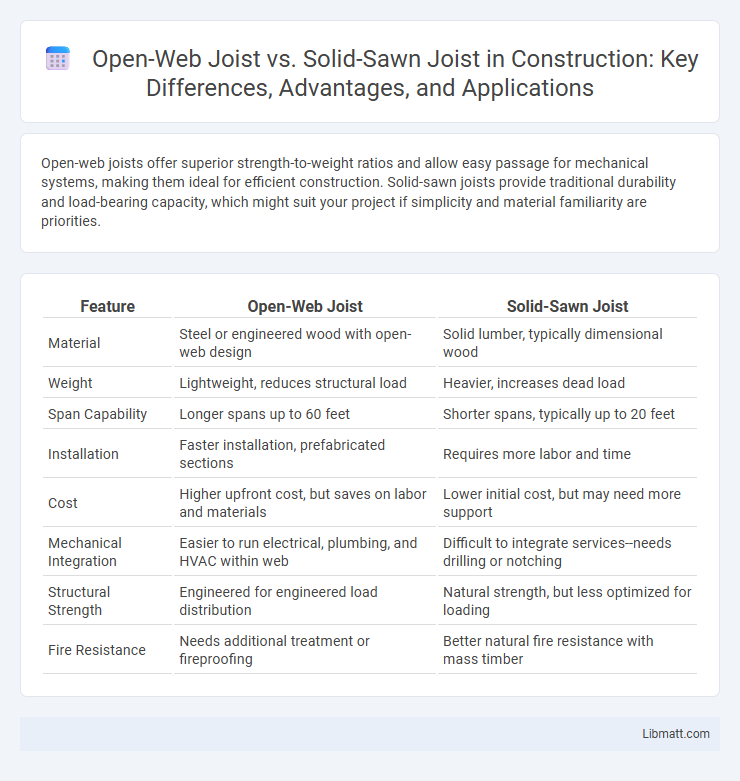Open-web joists offer superior strength-to-weight ratios and allow easy passage for mechanical systems, making them ideal for efficient construction. Solid-sawn joists provide traditional durability and load-bearing capacity, which might suit your project if simplicity and material familiarity are priorities.
Table of Comparison
| Feature | Open-Web Joist | Solid-Sawn Joist |
|---|---|---|
| Material | Steel or engineered wood with open-web design | Solid lumber, typically dimensional wood |
| Weight | Lightweight, reduces structural load | Heavier, increases dead load |
| Span Capability | Longer spans up to 60 feet | Shorter spans, typically up to 20 feet |
| Installation | Faster installation, prefabricated sections | Requires more labor and time |
| Cost | Higher upfront cost, but saves on labor and materials | Lower initial cost, but may need more support |
| Mechanical Integration | Easier to run electrical, plumbing, and HVAC within web | Difficult to integrate services--needs drilling or notching |
| Structural Strength | Engineered for engineered load distribution | Natural strength, but less optimized for loading |
| Fire Resistance | Needs additional treatment or fireproofing | Better natural fire resistance with mass timber |
Introduction to Floor Joist Systems
Open-web joists offer a lightweight, engineered solution with superior strength-to-weight ratios and easier installation for floor framing compared to traditional solid-sawn joists, which are made from natural lumber and provide reliable, uniform support. Open-web joists use triangulated metal webs, reducing material use while maintaining high load capacity and allowing easy routing of mechanical systems through the joist depth. Solid-sawn joists remain preferred in certain scenarios for their simplicity, availability, and performance in shorter spans without complex engineering requirements.
What is an Open-Web Joist?
Open-web joists are engineered wood components featuring a triangular web pattern made of metal or wood, designed to provide high strength-to-weight ratios. These joists allow for easier installation of mechanical systems such as plumbing, electrical wiring, and HVAC ducts due to their open framework. Compared to solid-sawn joists, open-web joists offer greater spanning capabilities and material efficiency while reducing overall structural weight.
What is a Solid-Sawn Joist?
A solid-sawn joist is a structural wood beam cut directly from a single, continuous piece of lumber, providing reliable strength and rigidity for floor and ceiling framing. Unlike open-web joists, solid-sawn joists are typically heavier and less flexible in spanning long distances, but they offer superior load-bearing capacity and simplified installation. Your choice between solid-sawn and open-web joists will depend on project requirements like span length, load, and ease of integration with mechanical systems.
Structural Performance Comparison
Open-web joists deliver superior structural performance due to their high strength-to-weight ratio, enabling longer spans with less material compared to solid-sawn joists. The truss-like design of open-web joists efficiently distributes loads and resists bending, reducing deflection under heavy loads. Solid-sawn joists, although simpler in design, typically require additional support for equivalent spans and are more prone to warping and splitting, which can compromise structural integrity over time.
Installation and Handling Differences
Open-web joists are lighter and easier to handle during installation compared to solid-sawn joists, reducing labor time and physical strain. Their prefabricated design allows for precise alignment and simpler attachment of mechanical systems, while solid-sawn joists require more manual cutting and adjustment on-site. The open-web structure also facilitates cable and duct routing, minimizing the need for drilling or notching common in solid-sawn joist installation.
Cost Considerations and Budget Impact
Open-web joists typically offer a cost-effective solution due to lower material usage and easier handling, reducing overall labor expenses compared to solid-sawn joists. Solid-sawn joists, while more expensive initially, provide greater load-bearing strength and may lower long-term maintenance costs in heavy-duty applications. Your budget impact depends on factors like span requirements and installation complexity, with open-web joists generally better suited for projects emphasizing budget efficiency.
Spanning Capabilities and Load-Bearing
Open-web joists provide superior spanning capabilities compared to solid-sawn joists, allowing for longer spans without the need for intermediate supports. Their engineered design distributes loads more efficiently, making them ideal for handling heavy live and dead loads in commercial and residential buildings. You benefit from increased design flexibility and optimized structural performance when choosing open-web joists over traditional solid-sawn counterparts.
Flexibility for HVAC, Plumbing, and Electrical
Open-web joists provide superior flexibility for HVAC, plumbing, and electrical installations due to their open steel truss design, allowing easy routing without cutting or drilling. Solid-sawn joists, being traditional lumber, require notching or drilling to accommodate systems, which can weaken structural integrity and increase labor time. Engineers and contractors often prefer open-web joists on projects where extensive mechanical, electrical, and plumbing (MEP) coordination is necessary.
Durability and Longevity
Open-web joists, constructed from engineered wood and steel, offer superior durability against warping, twisting, and insect damage compared to solid-sawn joists made from traditional lumber. The steel web design in open-web joists provides enhanced structural integrity and reduces long-term maintenance costs due to their resistance to environmental stressors. Solid-sawn joists, while strong initially, are more prone to cracking, splitting, and moisture-related deterioration, leading to reduced longevity in varying climates.
Choosing the Right Joist for Your Project
Open-web joists offer superior strength-to-weight ratios and facilitate easier installation of plumbing and electrical systems due to their open design, making them ideal for large spans and complex projects. Solid-sawn joists provide traditional solid wood support, offering simplicity and reliability in smaller-scale or renovation projects where cutting or notching may be necessary. Evaluating your project's load requirements, span length, and installation constraints will help determine whether open-web or solid-sawn joists best match your structural needs.
Open-web joist vs solid-sawn joist Infographic

 libmatt.com
libmatt.com